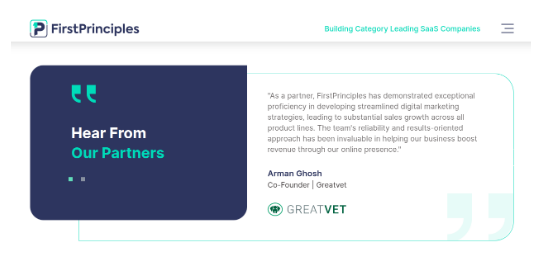
Home > Boost Conversion Rates of Your Landing Pages with These 8 Best Practices
Table of Contents
ToggleHave you heard the phrase, “You only get one chance to make a first impression”? Well, guess what? You have the power to make that first impression count and skyrocket your conversion rates!
Landing pages are the virtual storefronts of your online business, and they hold the key to capturing your visitors’ attention and turning them into loyal customers.
And here’s the exciting part: you have the opportunity to be among the elite few who crack the code of successful optimization.
With some tweaks and optimization, you can turn the tables in your favor and win over your visitors, converting them into loyal customers.
How?
We’re about to dive into eight tried-and-tested techniques that will take your landing pages from drab to fab. We will also share some solid statistics and insights from industry experts to back it all up. Let’s explore!
To begin with, let’s debunk some misconceptions and distinguish between fact and fiction.
The little secret: creating a new ad might not be the answer to improving your conversion rates. It might seem counterintuitive, but hear this out.
Now If you’re wondering what a good landing page conversion rate is, the answer isn’t straightforward. It depends on a bunch of factors like
Having said that, if you’re looking for a rough estimate, WordStream reports that the average across industries is about 2.35%.
But here’s the exciting part – there are landing pages with conversion rates of over 10%!
The question is, what’s their “magic wand,” and how can you get there too?
We’ve got some tips and tricks up our sleeves, so stick around!
Let’s talk about headlines! Did you know that the headline is one of the first things people notice when they land on your page?
And, on average, only 2 out of 10 people continue reading after the headline! That’s why your headline needs to be compelling enough to keep visitors engaged.
Tips for testing your landing page headline:
✅Clarity almost always wins over persuasion. Keep your landing pages simple and clear.
✅Promise to solve a unique problem your visitor is facing. Give them a solution!
✅Words that sell are your friend! Incorporate them to create a sense of urgency and appeal to your audience’s desires.
✅Words like “Free,” “Discover,” “Secret,” “Results,” “Quick,” “Guaranteed,” etc., can help you grab their attention.
✅ If you have a good sense of humor, don’t be afraid to use it to your advantage. Clever and witty headlines can be memorable and help your landing page stand out from the rest.
✅ Try starting your headline with “How to…” This phrase creates an expectation of learning and can help attract visitors looking for solutions.
✅ You can also try National Enquirer-type headlines. They are sensational and attention-grabbing and can create a curiosity gap. However, make sure they are truthful and align with your brand.
Even a tiny delay of one second in page load time could cause a 7% conversion reduction. That’s right, every second counts!
So, what could be slowing down your landing pages? One of the most common culprits is oversized images. Compressing and optimizing your images is essential to ensure they’re not slowing down your page load time.
So, make sure to check your images and optimize them for the web. There are several tools available that can help you with this. Your visitors will thank you, and your conversion rates will surely benefit.

[Image Source: Marketing Insider Group]
When it comes to making a purchase decision, nothing is more convincing than hearing positive feedback from someone who’s already used the product or service. That’s why adding testimonials and reviews to your landing page is a smart move.
But generic and vague testimonials won’t do much to sway potential customers. Instead, aim for testimonials that include specific details about the customer’s experience, such as their full name, business, and the results they achieved with your product or service.
When done right, testimonials can make a big impact on your conversion rates. They provide a level of trust and credibility that can be hard to achieve through other marketing tactics.
So, take the time to gather and showcase compelling testimonials on your landing page.

Isolation on landing pages is an influential strategy for driving conversions.
When we talk about isolation, we’re referring to the practice of creating a landing page that focuses on a single objective or task without any distractions.
This means removing unnecessary elements like header links or external links that could divert visitors’ attention from the main conversion goal.
Now, you might wonder why isolation is so effective.
It’s because of a psychological phenomenon known as the Zeigarnik Effect. This effect states that our brains experience a sense of dissonance or tension when we have unfinished tasks. We tend to remember these unfinished tasks more vividly, and they occupy our thoughts until we complete them.
By leveraging the power of isolation, you’re providing visitors with a clear and focused path. When they land on your page and see only one task or action to complete, their attention becomes laser-focused on that objective.
There are no distractions pulling them away or creating cognitive dissonance. This increases the likelihood that they will follow through and complete the desired conversion.
Imagine visiting a landing page with multiple options, links, and distractions. It can be overwhelming and make it difficult to decide what to do. On the other hand, an isolated landing page guides visitors directly to the desired action, simplifying the decision-making process and reducing friction.
So, when designing your landing pages, remove unnecessary elements, create a clear path toward your conversion goal, and make it easy for visitors to focus on that specific action.
Let’s talk about the powerful role of directional cues on landing pages. These cues act as helpful finger pointers, guiding visitors’ attention to specific elements or actions on the page.
Now, directional cues can be classified into two types: explicit and implicit.
Explicit cues are like those bold arrows or visual indicators that leave no doubt about where to focus your attention. They shout, “Hey, look over here!” and point directly at the form or button you’re supposed to click. They’re like the signposts on the road, guiding you to your destination with utmost clarity.
On the other hand, implicit cues are more subtle and crafty. They work their magic by leveraging design elements, visuals, or even a person’s gaze in an image. These cues don’t scream for attention but rather gently nudge your eyes in the desired direction.
By strategically incorporating both explicit and implicit directional cues, you can wield the power of visual persuasion to guide visitors’ attention and influence their behavior.
The goal is to create an immersive user experience that feels natural and intuitive, leading visitors to take the desired action easily.
Now, here’s the thing: when your landing page is overloaded with a hefty word count, it can overwhelm and discourage your visitors. They want to quickly grasp the essence of your message without having to wade through a sea of text.
Landing pages with less copy have been found to achieve an average conversion rate of 14%, compared to just 11% for landing pages with an excessive copy.
By trimming down your word count and focusing on concisely conveying the essential information, you create an inviting and approachable experience for your visitors. It’s like serving them bite-sized pieces of information that are easy to digest and savor.
To make your copy more reader-friendly and engaging, consider incorporating text formatting techniques.
Break up large blocks of text by using bullets, headers, and spacing. These formatting elements help create visual breaks and make it easier for visitors to skim and digest the information you’re presenting.
The goal is to provide the necessary details in an easily scannable format. So, take a critical look at your landing page copy and ask yourself:
By answering these questions and implementing the necessary changes, you’ll optimize your landing page for conversion success.
Have you noticed those whiteboard-animated videos you often come across on websites? Those are called explainer videos- and if done right, these little animated masterpieces can potentially boost your conversion rates by a whopping 30% or even more!
So, why are explainer videos so effective? Well, it all comes down to our attention spans. In today’s fast-paced world, people prefer content that’s easy to consume and understand. And that’s exactly what explainer videos offer.
By combining visuals and storytelling, they grab attention, evoke emotions, and deliver your message concisely and engagingly.
Now, hold your horses before you start planning your blockbuster video. Explainer videos can be a bit tricky, so here are a few tips to keep in mind:
First and foremost, be mindful of the cost and A/B testing challenges. Creating multiple unique videos for split testing can be expensive and time-consuming. So, plan your approach carefully and consider the potential return on investment.
While animation plays a significant role, the real magic of an explainer video lies in its script. Take the time to craft a killer script that clearly communicates your value proposition and resonates with your target audience. A well-crafted script is the foundation for a captivating video.

Think of A/B testing as your lab experiment. You create two versions of your landing page: Version A and Version B. Each version has a slight difference in design, copy, or layout. Then, you unleash them and see which performs better.
Why is this important? Well, it’s because humans are unpredictable creatures. What works for one person might not work for another. A/B testing helps you uncover what resonates with your audience and what makes them click that “Convert” button.
Let’s consider that changing the color of your CTA button from blue to green will increase conversions. With A/B testing, you can put that theory to the test. Half of your visitors see the blue button (Version A), while the other half see the green button (Version B).
You collect data on how each version performs, and voila! You have empirical evidence to back up your design decision.
But here’s the key: A/B testing isn’t a one-time thing. It’s an ongoing process of iteration and improvement. You keep testing and refining, uncovering new insights, and making incremental changes to boost conversion rates.
Experts’ Opinion
Experts in the field have emphasized the importance of A/B testing. Let’s hear what they have to say about it:
1. Tim Ash

Statement: Tim Ash, CEO of SiteTuners and author of “Landing Page Optimization: The Definitive Guide to Testing and Tuning for Conversions,” notes that –without testing, you’re just guessing.
Ash highlights the inherent uncertainty of relying solely on assumptions or subjective opinions when designing and optimizing landing pages.
Testing allows marketers to gather empirical evidence and insights into user behavior, preferences, and motivations. By systematically testing different elements and variations, one can move away from guesswork and make informed decisions based on measurable results.
Furthermore, Ash’s philosophy acknowledges that optimization is an ongoing process. Testing provides a feedback loop that allows for continuous refinement and improvement. It promotes a culture of experimentation, learning, and adaptation, ultimately leading to better-performing landing pages and enhanced conversion rates.
2. Chris Goward

Statement: Chris Goward, founder, and CEO of WiderFunnel and author of “You Should Test That!” Goward stresses the need for A/B testing to be an ongoing process rather than a one-time event.
Chris Goward’s philosophy of ongoing A/B testing, as highlighted in his book “You Should Test That!” recognizes the dynamic nature of marketing and the need for continuous experimentation.
Goward highlights the importance of iterative optimization and the pursuit of long-term success by emphasizing that A/B testing should be an ongoing process rather than a one-time event.
Goward’s philosophy aligns with the concept of continuous improvement, encouraging marketers to view A/B testing as a fundamental part of their marketing strategy. By embracing ongoing testing, marketers can stay ahead of the curve, drive consistent optimization, and unlock the full potential of their landing pages.
3. Neil Patel

Statement: Neil Patel recommends A/B testing to “Run, Rinse, and Repeat
– to find the best version of your landing page.
Neil Patel, a renowned digital marketer, strongly advocates for A/B testing to find what works best for your landing page. His philosophy aligns with the fundamental principle of A/B testing. He emphasizes the importance of experimentation and data-driven decision-making in optimizing landing pages.
By conducting A/B tests, you can move beyond assumptions and opinions and rely on objective results to guide your design and optimization choices.
The strength of Neil Patel’s approach lies in the focus on continuous improvement. A/B testing allows you to iterate and refine your landing pages over time based on real-world data rather than relying solely on intuition or best practices. This iterative process helps you uncover incremental gains and unlock the potential for higher conversion rates.
However, it’s necessary to approach A/B testing with a critical mindset. While it provides valuable insights, it’s important to design experiments carefully, ensuring that you test one element at a time to isolate each change’s impact accurately.
Additionally, the sample size and duration of the test should be statistically significant to draw reliable conclusions.
Furthermore, it’s worth noting that A/B testing is not a standalone solution. It should be complemented by qualitative research, user feedback, and a deep understanding of your target audience. A holistic approach that combines quantitative and qualitative insights will provide a more comprehensive understanding of user behavior and preferences.
Landing page optimization is a work in progress – you need to keep fine-tuning your messaging and end-user experience to make sure that you push further toward driving more conversions.
And make use of data. Tailor your offer to match the user’s intent by following page performance metrics like heat maps, bounce rates, engagement rates, etc. This proactive and data-driven approach empowers you to make informed adjustments that truly resonate with your audience, leading to those coveted conversions.
And let’s not forget the power of A/B testing. This relentless pursuit of optimization can elevate your conversion rates by an average of 49%. With each iteration, you inch closer to uncovering the perfect formula that resonates with your audience and gives you massive results.
So, analyze results and keep iterating your landing pages according to these practices to tap into wider markets and get the best ROI.
Pushkar Sinha is the Head of Digital Marketing at FirstPrinciples Growth Advisory. With 15+ years of expertise, he specializes in SEOfor European, American, and Indian markets, both in agency and in-house roles. His holistic skill set encompasses Google Ads, Affiliate Marketing, SEO, SEM, PPC, E-Commerce, and Project Management. Pushkar is...